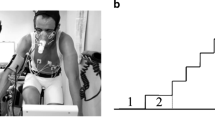Summary
Anaerobic and aerobic-anaerobic threshold (4 mmol/l lactate), as well as maximal capacity, were determined in seven cross country skiers of national level. All of them ran in a treadmill exercise for at least 30 min at constant heart rates as well as at constant running speed, both as previously determined for the aerobic-anaerobic threshold. During the exercise performed with a constant speed, lactate concentration initially rose to values of nearly 4 mmol/l and then remained essentially constant during the rest of the exercise. Heart rate displayed a slight but permanent increase and was on the average above 170 beats/min. A new arrangement of concepts for the anaerobic and aerobic-anaerobic threshold (as derived from energy metabolism) is suggested, that will make possible the determination of optimal work load intensities during endurance training by regulating heart rate.
Similar content being viewed by others
References
åstrand, P.-O., Rodahl, K.: Textbook of work physiology. New York: McGraw Hill 1970
Costill, D. L.: Metabolic responses during distance running. J. Appl. Physiol. 28, 251–255 (1970)
Daniels, J. T., Yarbrough, A., Foster, C.: Changes in VO2 max and running performance with training. Eur. J. Appl. Physiol. 39, 249–254 (1978)
Davies, C. T. M., Knibbs, A. V.: The training stimulus. Int. Z. Angew. Physiol. 29, 299–305 (1971)
Davis, J. A., Vodak, P., Wilmore, J. H., Vodak, J., Kurtz, P.: Anaerobic threshold and maximal aerobic power for three modes of exercise. J. Appl. Physiol. 41, 544–550 (1976)
Ekelund, L.-G., Holmgren, A.: Circulatory and respiratory adaptation during long-term, non-steady exercise, in the sitting position. Acta Physiol. Scand. 62, 240–255 (1964)
Hirsch, L.: Trainingsformen zur Verbesserung der aeroben KapazitÄt. Leistungssport (Beiheft) 7, 93–103 (1977)
Hohorst, H. J.: L-(+)-Lactat, Bestimmung mit Lactatdehydrogenase und DPN. In: Methoden der enzymatischen Analyse (Bergmeyer, H. U., Hrsg.). Weinheim: Verlag Chemie 1962
Hollmann, W.: Höchst- und DauerleistungsfÄhigkeit des Sportlers. München: Barth 1963
Katch, V., Weltman, A., Sady, S., Freedson, P.: Validity of the relative percent concept for equating training intensity. Eur. J. Appl. Physiol. 39, 219–227 (1978)
Keul, J., Haralambie, G., Arnold, T., Schumann, W.: Heart rate and energy-yielding substrates in blood during longlasting running. Eur. J. Appl. Physiol. 32, 279–289 (1974)
Keul, J., Huber, G., Kindermann, W.: Unterschiedliche Wirkung des Skilanglaufes und des Skiabfahrtslaufes auf Kreislauf und Stoffwechsel. Sportarzt Sportmed. 26, 49–58 (1975)
Kindermann, W., Huber, G., Keul, J.: Aerobe Energiebereitstellung und Herzfrequenz wÄhrend und nach verschiedenen Trainingsmethoden des Mittelstrecklers. Leistungssport 5, 66–70 (1975)
Kindermann, W., Keul, J.: Anaerobe Energiebereitstellung im Hochleistungssport. Schorndorf: Hofmann 1977
Kindermann, W., Keul, J., Simon, G., Reindell, H.: Anpassungserscheinngen durch Schul- und Leistungssport im Kindesalter. Z. Sportwiss. 8, 222–234 (1978)
Lehmann, M., Keul, J.: Katecholaminausscheidung und Katecholaminblutspiegel bei verschiedenen Belastungen (im Druck)
Liesen, H., Mader, A., Heck, H., Hollmann, W.: Die AusdauerleistungsfÄhigkeit bei verschiedenen Sportarten unter besonderer Berücksichtigung des Metabolismus: Zur Ermittlung der optimalen BelastungsintensitÄt im Training. Leistungssport (Beiheft) 7, 63–79 (1977)
Londeree, B. R., Ames, S. A.: Maximal steady state versus state of conditioning. Eur. J. Appl. Physiol. 34, 269–278 (1975)
Mader, A., Liesen, H., Heck, H., Philippi, H., Rost, R., Schürch, P., Hollmann, W.: Zur Beurteilung der sportartspezifischen AusdauerleistungsfÄhigkeit im Labor. Sportarzt Sportmed. 27, 80–88, 109–112 (1976)
Rowell, L. B.: Circulation. Med. Sci. Sports. 1, 15–22 (1969)
Saltin, B., åstrand, P.-O.: Maximal oxygen uptake in athletes. J. Appl. Physiol. 23, 353–358 (1967)
Saltin, B., Stenberg, J.: Circulatory response to prolonged severe exercise. J. Appl. Physiol. 19, 833–838 (1964)
Shephard, R. J.: Intensity, duration and frequency of exercise as determinants of the response to a training regime. Int. Z. Angew. Physiol. 26, 272–278 (1968)
Wasserman, K.: Breathing during exercise. N. Engl. J. Med. 298, 780–785 (1978)
Wasserman, K., McIlroy, M. B.: Detecting the threshold of anaerobic metabolism in cardiac patients. Am. J. Cardiol. 14, 844–852 (1964)
Wasserman, K., Whipp, J., Koyal, S. N., Beaver, W. L.: Anaerobic threshold and respiratory gas exchange during exercise. J. Appl. Physiol. 35, 236–243 (1973)
Author information
Authors and Affiliations
Additional information
With support of Bundesinstitut für Sportwissenschaft, Köln-Lövenich
Rights and permissions
About this article
Cite this article
Kindermann, W., Simon, G. & Keul, J. The significance of the aerobic-anaerobic transition for the determination of work load intensities during endurance training. Europ. J. Appl. Physiol. 42, 25–34 (1979). https://doi.org/10.1007/BF00421101
Accepted:
Issue Date:
DOI: https://doi.org/10.1007/BF00421101




